Gearbox disassembly and repair are required for the following faults
Increased noise in the gearbox:
- - bearing wear;
- - wear of gear teeth and synchronizers;
- - axial displacement of shafts.
Difficult gear shifting:
- - wear of the spherical joint of the gear shift lever, lack of lubrication in the unit;
- - deformation of the gear shift lever;
- - burrs, bends, contamination of rod seats, jamming of locking crackers;
- - contamination of the splines of the sliding clutch and hub;
- - deformation of the shift forks gears.
Spontaneous disengagement or fuzzy engagement of gears:
- - wear of the dimples for the balls on the rods, breakage of the retainer springs;
- - wear of the synchronizer locking ring;
- - breakage of the synchronizer spring;
- - wear of the synchronizer clutch teeth or the synchronizer ring gear.
Low oil level or oil leak:
- - wear of the primary and secondary shaft seals;
- - loosening of the gearbox housing covers, damage to the sealing gaskets;
- - loosening of the clutch housing to the gearbox housing.
The listed malfunctions can be caused by other reasons, the elimination of which does not require removing and disassembling the gearbox gears.
You will need: screwdrivers (two), replaceable heads "13", "17", extension, ratchet, keys "10", "13" (two), "17", "19", "30", impact screwdriver, snap ring pliers, hammer, universal pullers.
Drain the oil from the gearbox housing, if you did not do this when removing it from the car.

Unscrew the three nuts securing the gear selector housing and remove the mechanism.
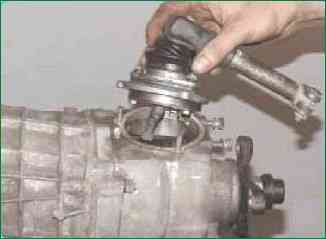
Disassembly of the mechanism is described in the article - "Removal and adjustment of the gear shift mechanism of the Niva Chevrolet since 2009"
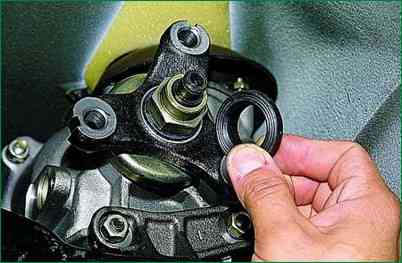
Remove the centering ring seal

Holding the flange of the elastic coupling from turning, unscrew the flange fastening nut.
By unscrewing the nut, you simultaneously press the centering ring from the secondary shaft.

Remove the lock washer
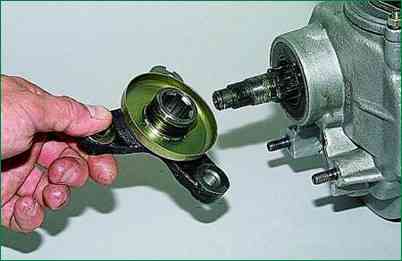
Remove the elastic flange couplings
We install the gearbox with the clutch housing on the workbench.
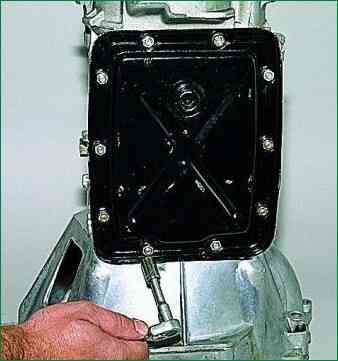
Using a "10" head, unscrew the ten nuts securing the lower cover of the gearbox.
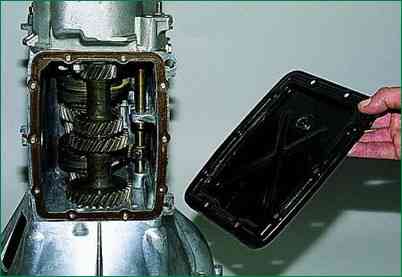
Remove the cover
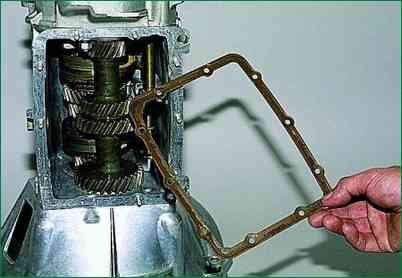
Remove the sealing gasket.
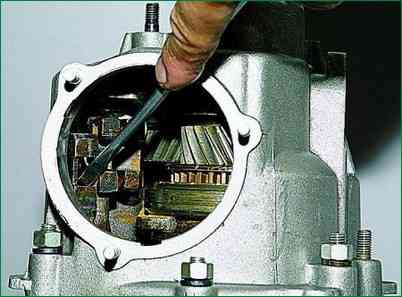
Using a screwdriver, push the rod of the fork of the first and second gears down through the hole of the gear selection mechanism (this engages the second gear).
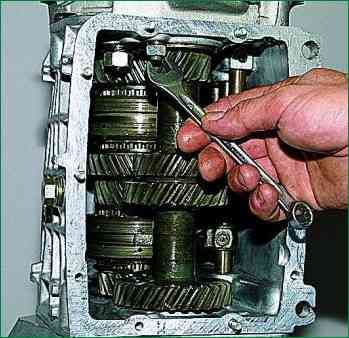
Using a 13 mm wrench, unscrew the nut of the rear cover fastening, located inside the gearbox housing.

Using a 13 mm wrench, unscrew the five nuts securing the rear cover, located on the outside of the case.
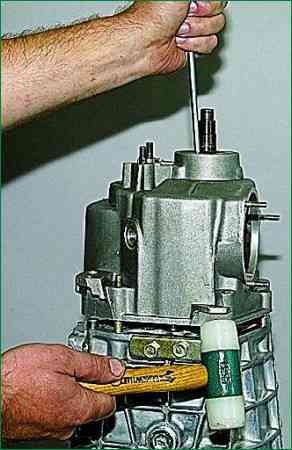
Tap the lugs of the cover with a hammer, while using a screwdriver (or with a suitable piece of pipe with the secondary shaft seal removed), hold the rear bearing on the secondary shaft.
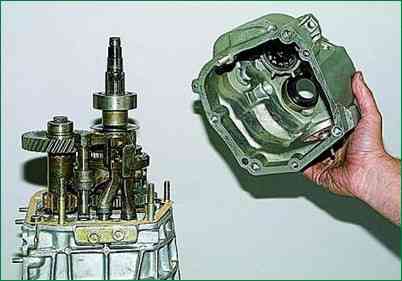
Slide the cover off the studs and remove it, turning it clockwise (looking from the secondary shaft tail) to prevent the cover from touching the rods and the V and reverse gear block.

Remove the cover gasket.
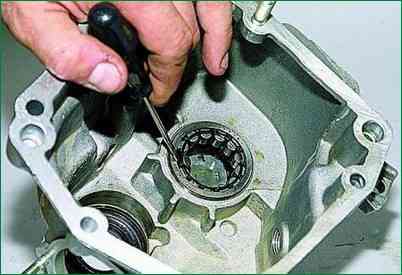
To replace the bearing of the block of gears of the 5th gear and reverse gear, we pry the bearing rollers with a screwdriver and take them out rollers from the separator
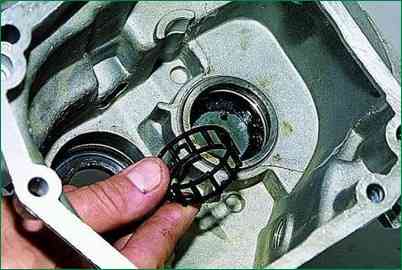
Removing the separator

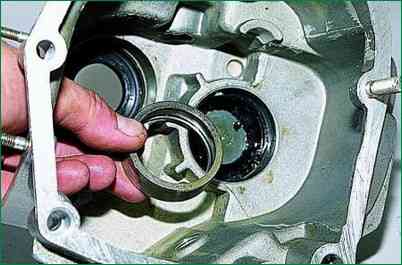
Having hooked the outer ring of the bearing, we take it out of the socket of the rear cover.

Removing the thrust ring of the secondary shaft rear bearing.
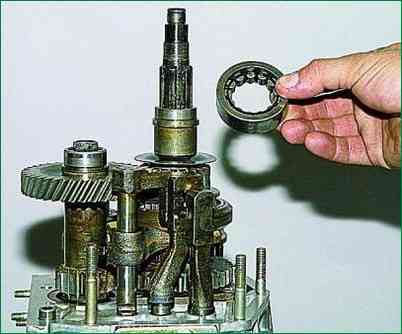
Removing the outer bearing ring with the separator and rollers.
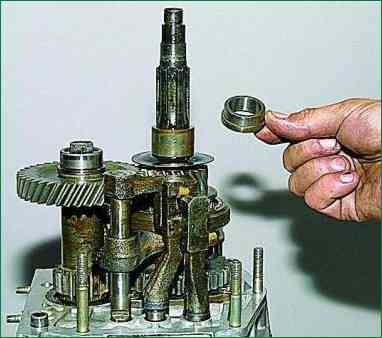
Removing the inner bearing ring.

Removing the spacer sleeve
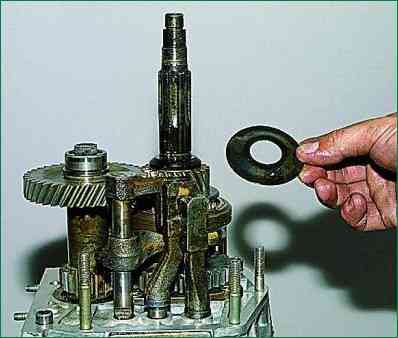
Remove the oil deflector washer.
To lock the shafts from turning, it is necessary to engage two gears. The second gear was engaged when removing th of the rear cover.
Before engaging reverse or V gear, release the fork for engaging these gears.
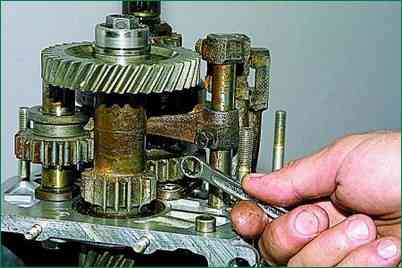
To do this, use a 10 mm wrench to unscrew the bolt securing the fork to the rod.
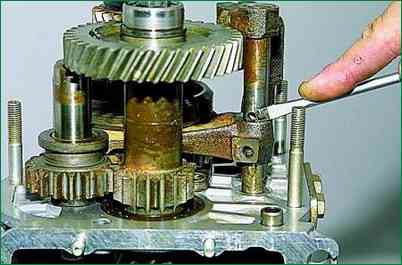
Pressing the fork down with a screwdriver, we engage the reverse gear
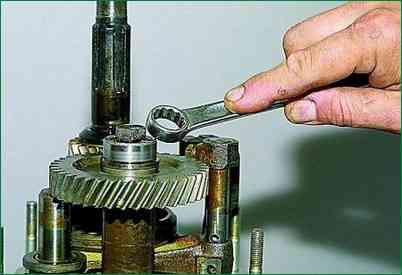
Using a spanner (head) "on 17" we unscrew the bolt securing the block of gears V transmission and reverse.
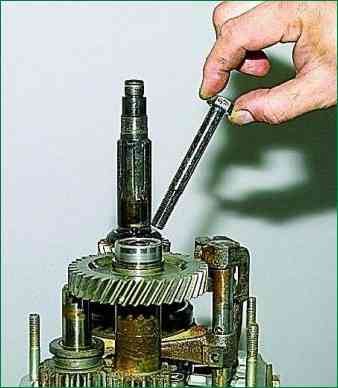
Removing the bolt
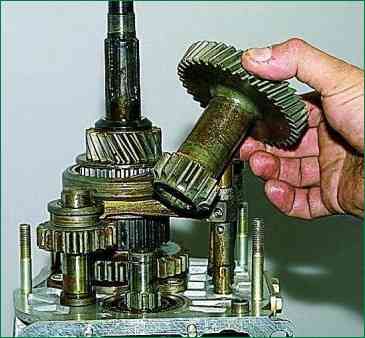
Remove the gear block from the intermediate shaft splines.
Clamp the V and reverse gear block in a vice with soft metal jaw pads.
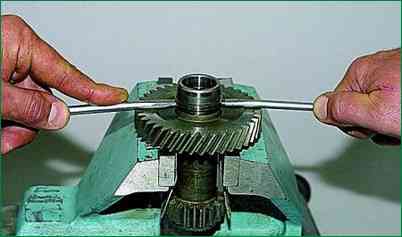
Use two screwdrivers to press off the inner bearing ring of the gear block
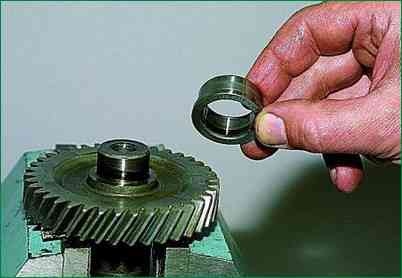
Removing the inner ring.
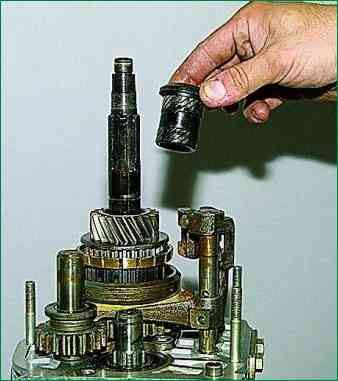
Removing the bushing of the gear of the V gear
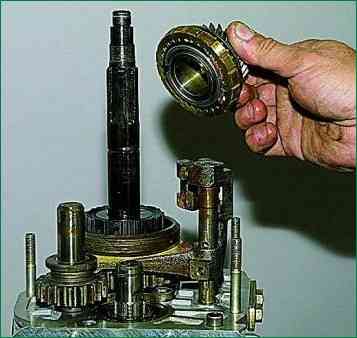
Removing the gear itself with the locking ring of the synchronizer

Removing the hub

Removing the synchronizer clutch.
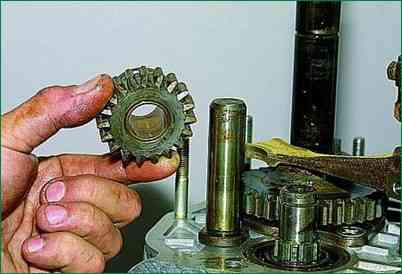
Having turned the fork of the V gear and reverse gear on the rod to the secondary shaft, remove the intermediate gear of the reverse gear.
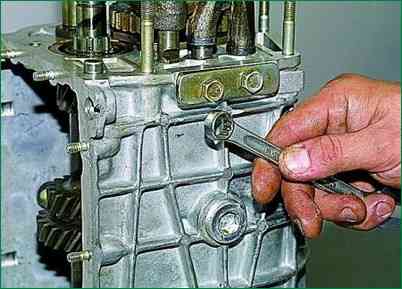
Using a 13 mm open-end wrench, unscrew the two bolts securing the cover of the retainers
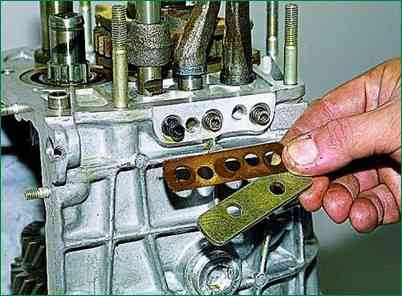
Remove the cover and gasket

Remove the springs of the retainers (the spring of the rod of the V gear and reverse for different from the other two and has a dark color coating).
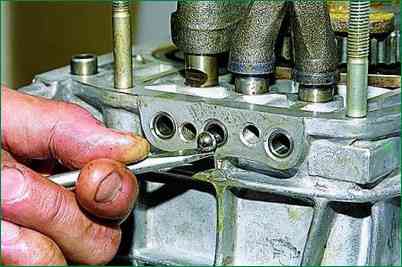
Use a magnetized screwdriver to remove all three clamps.
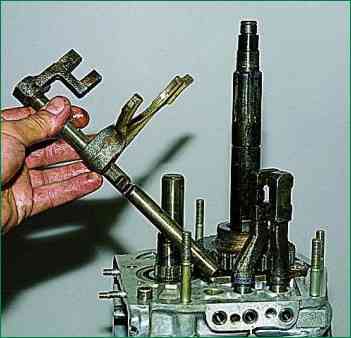
Removing the V gear and reverse gear engagement rod with the fork

Removing the fork from the rod
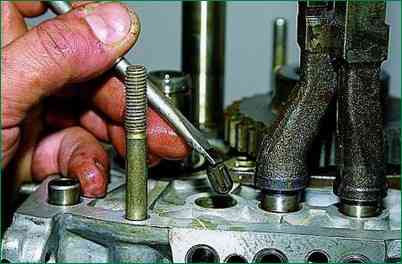
Use a magnetized screwdriver to remove the locking cracker from the gearbox housing hole, which is located between the housing sockets for the V and reverse gear rods and III–IV gears.
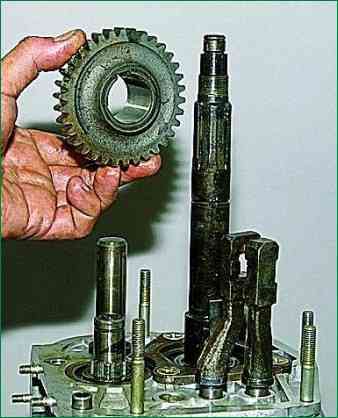
Remove the driven gear of the rear from the secondary shaft transmission.

We take out the key from the shaft groove.
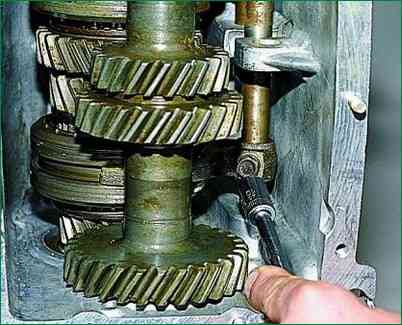
Using a 10 mm socket, unscrew the bolt securing the III–IV gear fork to the rod.
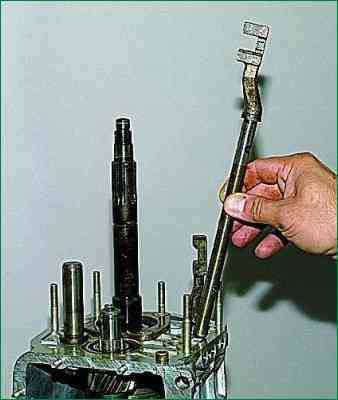
Remove the rod.

A locking cracker is inserted into the hole in the rod, we take it out.
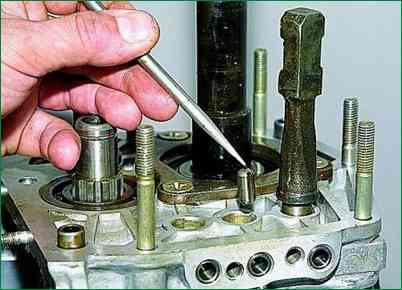
Using a magnetized screwdriver, we take out the locking cracker from the hole in the gearbox housing, which is located between the housing sockets for the rods of the I–II and III and IV gears
- (this cracker is noticeably longer than the cracker located between the V-reverse gear engagement rod and the III-IV gear engagement rod).
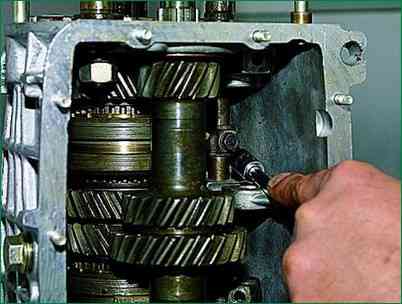
Using a 10 mm socket, unscrew the bolt securing the I-II gear fork to the rod

We take out the rod.
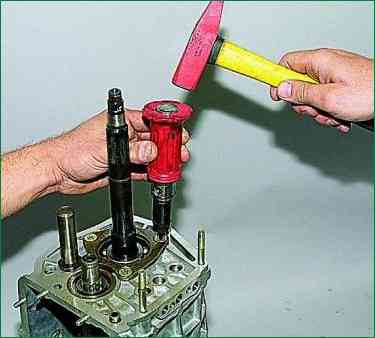
Using an impact screwdriver with a Phillips tip, unscrew the three screws securing the locking plate of the intermediate bearing of the secondary shaft.
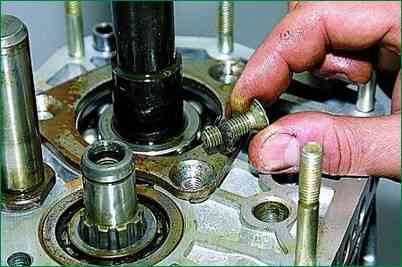
The screws are locked with special washers

Remove the locking plate
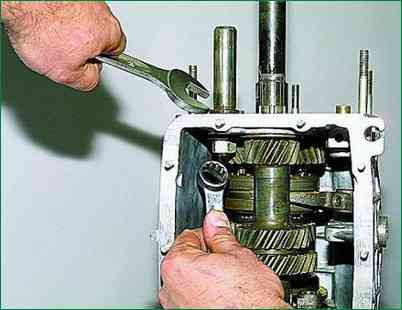
Using a 19 mm open-end wrench, unscrew the nut securing the axle of the intermediate gear of the reverse gear, holding the axle from turning with a wrench of 24».
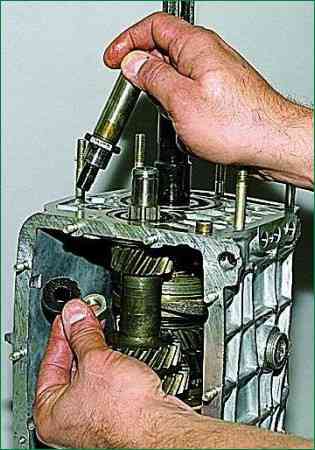
We take out the axis of the intermediate gear of the reverse.
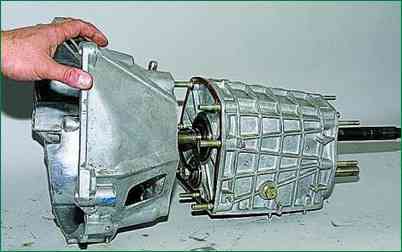
After unscrewing the clutch housing fastening nuts, we separate the clutch and gearbox housings.
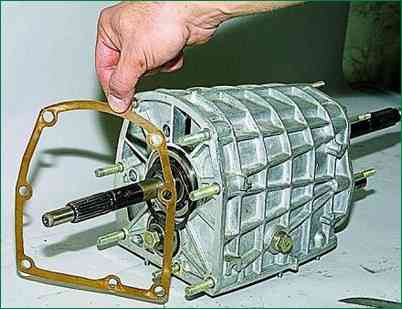
Remove the gasket.
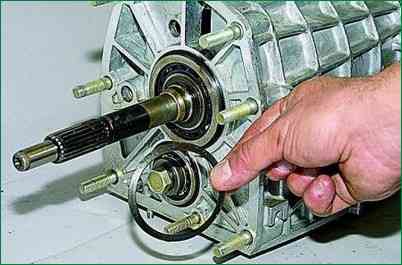
Remove the spring washer with a conical surface from the primary shaft (its smaller diameter faces the bearing).
Clamp the splined part of the primary shaft in a vice with soft metal jaw pads.

Use a 19 mm open-end wrench to unscrew intermediate shaft front bearing clamp washer bolt
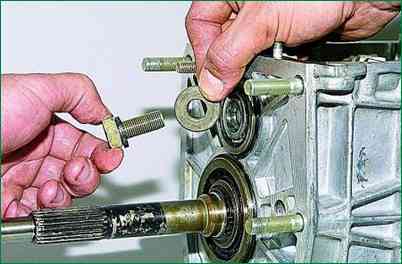
Remove the bearing clamp washer.
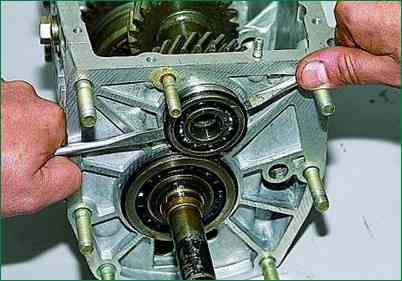
Using two screwdrivers, pry up the front double-row bearing of the intermediate shaft by the mounting ring.
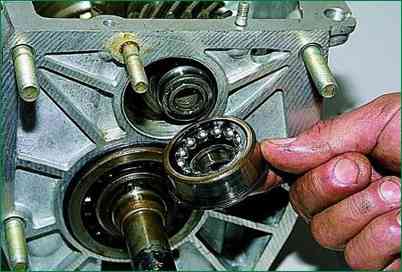
Remove the bearing.
When removing the bearing, its rear inner ring may remain on the shaft.
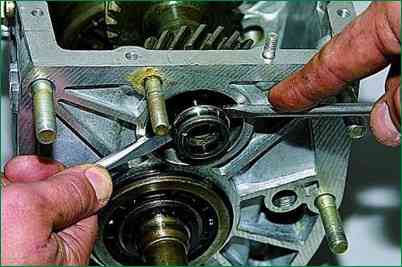
Using two screwdrivers, press off the rear inner bearing race and remove it
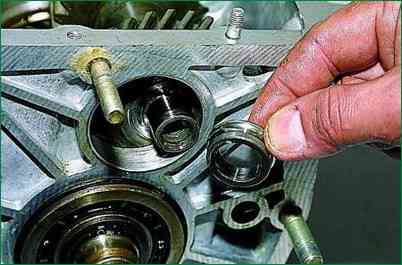
We take out the thrust ring of the rear intermediate bearing shaft
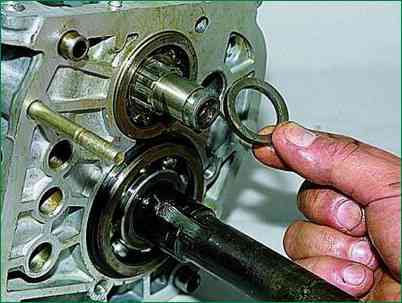
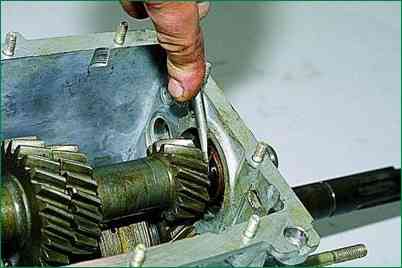
Having inserted a screwdriver between ends of the bearing and the gear of the first gear of the intermediate shaft, we move the rear bearing.

We take out the outer ring of the bearing ka with a separator and rollers.

Remove the inner bearing ring from the shaft nose.
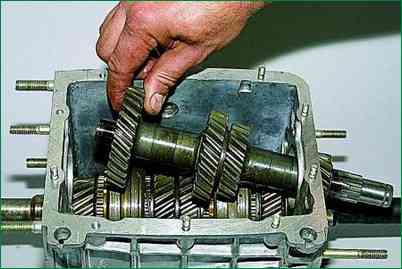
Moving the intermediate shaft back, we remove it from the gearbox housing.
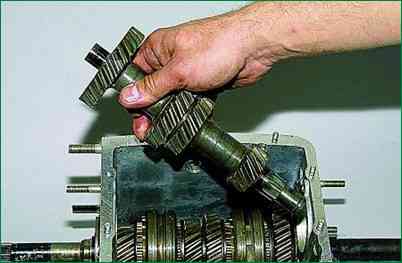
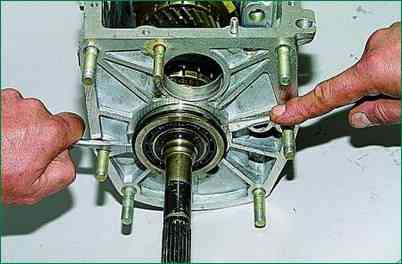
Pry the rear bearing of the primary shaft with two screwdrivers by the mounting ring, remove the primary shaft assembly with the bearing and the synchronizer locking ring.
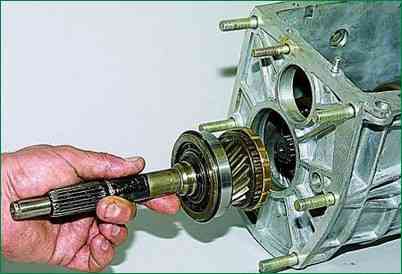

Remove the needle bearing from the front toe of the secondary shaft
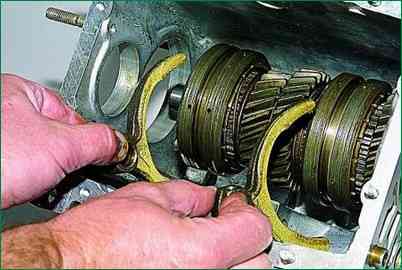
Remove the forks of engagement I and II, III and IV gears.
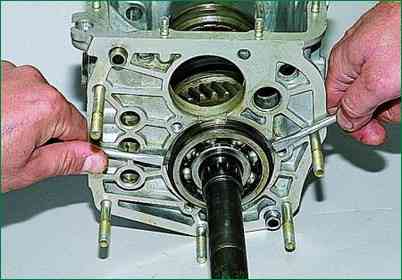
Using two screwdrivers, pry the intermediate bearing of the secondary shaft by the mounting ring and remove it.
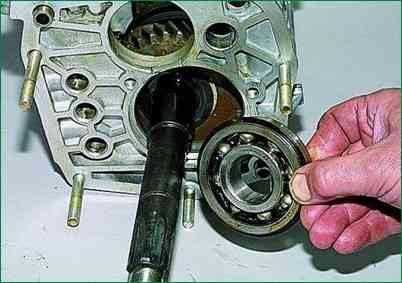
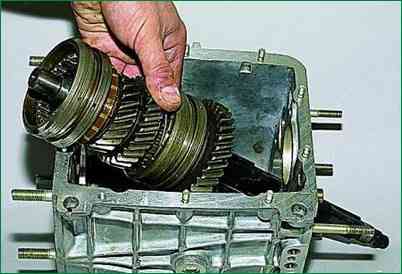
Tilting, we remove from the gearbox housing the secondary shaft assembled with gears, couplings, hubs and locking rings of synchronizers.
We assemble the gearbox in the reverse order.
If, when removing the front double-row bearing of the intermediate shaft, its rear inner ring remains on the shaft, then the bearing must be assembled before installation.
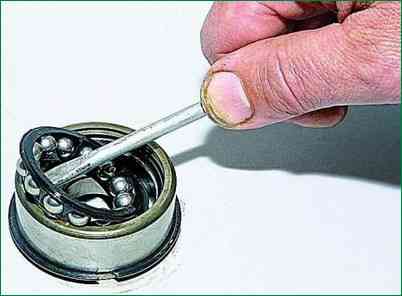
To do this, carefully remove the separator with balls from the outer ring of the bearing with a screwdriver and put it on the inner ring (removed from the shaft).
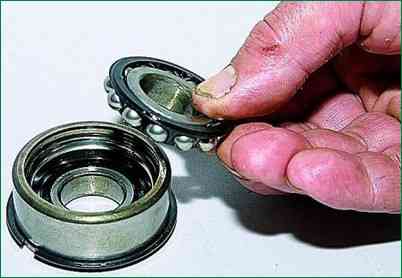
Insert the separator with balls and inner ring into the outer ring of the bearing.
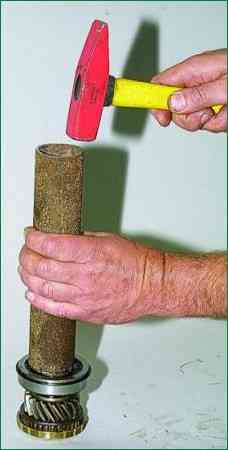
When assembling the primary shaft, press the bearing onto the shaft with a suitable piece of pipe, resting on its inner ring.
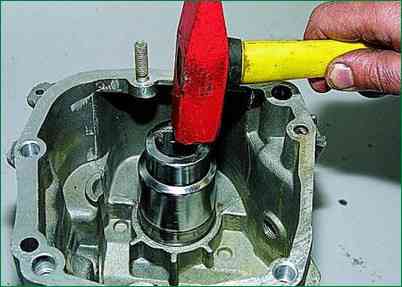
After installing the secondary and intermediate shafts, we press in the front and rear bearings of the intermediate shaft, the intermediate bearing of the secondary shaft and the inner ring of the bearing of the gear block.
We press the outer ring of the bearing of the 5th gear and reverse gear gear block into the socket of the rear cover with a tool head of a suitable size (a piece of pipe).
We insert the separator and rollers into the outer ring of the bearing.
To prevent the bolt of the 5th gear and reverse gear gear block from loosening, we apply thread sealant to the thread of the bolt.
For ease of installation of the rear cover, we install the rear bearing assembly on the secondary shaft. It is advisable to lubricate all sealing gaskets with a thin layer of silicone sealant.
When assembling the gear selection mechanism, apply Litol-24 grease to the ball joint.
For disassembling the primary and secondary shafts, see the article - "Disassembling the primary and secondary shafts of the VAZ-2123 gearbox".





